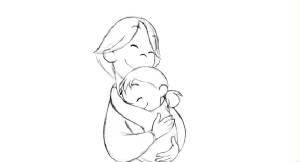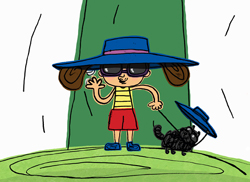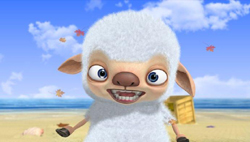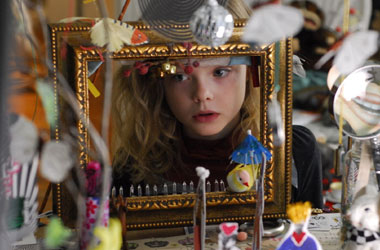Musings
an Online Journal of Sorts
By Alyce Wilson
April 8, 2008 - Stories of Imagination

The Pixar Story
On Sunday we saw more films at the 2008 Philadelphia Film Festival, but we started later in the day, at 2:30 at The Bridge.
The Bridge is my favorite theater in the area, because it has really comfortable seats. You can put the armrest up between the seats. The concessions are good, and the view of the screen and the sound are great.
They also happened to be the most organized theater so far.
Volunteers
directed us back to the theater, and we didn't even have to wait in any
lines.
Our first movie was The Pixar Story, a documentary by Leslie Iwerks, whose grandfather, Ub Iwerks, was the co-creator of Mickey Mouse. The film traces the development of Pixar, from early days to the recent purchase by Disney. It's based primarily on interviews with key players, and it includes a lot of archival footage, home movies shot by the co-creators of Pixar that showed their process from a personal point-of-view. She also made good use of newspaper clippings, still photographs, drawings, and film clips.
Despite her connection to Disney, Iwerks portrayed the sometimes troubled relationship between Pixar and Disney with an even hand, including comments from representatives both sides. Really, it was an old story: the conflict between an established institution and a brash new creative upstart. Ironically, the recent acquisition gave the Pixar founders prominent positions at Disney, and one of them now heads the animation departments of both Pixar and Disney.
One of the saddest and most ironic aspects of the story is that 3D animation was originally scorned, and as of just a few years ago, it had become so popular that Disney (pre-acquisition) dismissed many of their 2D artists. Of course, the creative minds at Pixar knew that an animated film is only as good as the story. This was illustrated by the creative process behind Toy Story 2.
Originally conceived as a direct-to-video sequel, Toy Story 2 then became slated for a theater release. Up until that point, it had been handled by a separate team, as the director of the first film, John Lasseter, was overseas on a promotional tour. When he returned and looked at the film, he said the story line just wasn't working and led an ambitious rewrite that called for almost an entirely new animated film. Because of that attention to story, though, the sequel did even better than the original and even won critical praise.
Hopefully, the creative minds behind Pixar will turn that same attention to 2D animation and revive that sadly neglected department at Disney.
We had to hurry to our next showing, which was a shorts program at the International House called Family Funimation, a collection of family-friendly animated shorts.
The first film on the program was "Lucien, Superstar" by Samantha Leriche-Gionet. It was bare-bones, outline hand-drawn animation, featuring a little boy warming up to play his guitar for a wildly appreciative audience. The guitar is short but cute, and it got a lot of laughs.
Next up was "Last Time in Clerkenwell" by Alex Budovsky, which appeared to be done with cut-out paper, but that might have simply been the design style. It was set to a nonsensical pop song and, according to Budovsky's site, tells the story of cuckoos, who join forces to defeat an interstellar enemy. While the short featured animals, they were clearly fighting a war, and I thought it was a strange selection for children. We had seen a previous short film by Budovsky called "Brazil," which was also set to music, and which I enjoyed more.
 Hyun-min
Lee's "The
Chestnut Tree" is a hand-drawn 2D animation that tells the story
of a young woman who awakens into a dreamworld which she explores with
her mother and some animal friends. The film is dedicated to Lee's late
mother, and it's simply and beautifully done. (Here's a short
interview with the director.)
Hyun-min
Lee's "The
Chestnut Tree" is a hand-drawn 2D animation that tells the story
of a young woman who awakens into a dreamworld which she explores with
her mother and some animal friends. The film is dedicated to Lee's late
mother, and it's simply and beautifully done. (Here's a short
interview with the director.)
"Zoologic" by Nicole Mitchell was another hand-drawn 2D animation, telling a simple story, this one a silly tale about a fussy zookeeper trying to arrange animals to his liking. Naturally, they rebel, with hilarious results. My favorite is the benevolent gorilla, distraught at having her kitten taken away. She befriends a wandering penguin, and they team up against the zookeeper.
Another film with a simple concept was the stop motion animation "Crank Balls" by Devin Bell. Three cranky creatures mark endless hash marks onto a piece of paper, until one of them finds happiness, much to the other's distress. (See a sampling of Devin's work at YouTube.) This was one of my favorites.
Cal Arts student (which, incidentally, is the animation program developed by Disney) Sean Jiminez, whose work we had seen in previous festivals and who has worked on four features with Disney, contributed "Why Can't I Fly," an animated ornithology lesson in the style of 1950s animation. Although the artwork was a delight, the script was simply dry facts about birds.
Next up, "Automoto" by Canadian animators Neil and Cathy McInnes was a stop-motion animation. It told the story of a robot living who works in an isolated mechanized workshop and longs for a dog. This film was short and easy to understand. The subject matter was definitely appropriate for children, but I wondered if the children would have been frightened by the skeletal forms of the robots.
 "A
Sunny Day" by German animator Gil
Alkabetz definitely appealed to children, with colorful, hand-drawn
2D animation. The sun wakes up, goes through his morning routine, and
then cheerily greets people, only to be met with sunglasses, broad-brimmed
hats, and umbrellas. This short was whimsical and well-received by the
audience.
"A
Sunny Day" by German animator Gil
Alkabetz definitely appealed to children, with colorful, hand-drawn
2D animation. The sun wakes up, goes through his morning routine, and
then cheerily greets people, only to be met with sunglasses, broad-brimmed
hats, and umbrellas. This short was whimsical and well-received by the
audience.
On a more reflective note, the 3D animated short "Insight" by Salvador Simo Busom of Denmark tells the story of a relationship between a homeless woman and a little girl, drawn together by a mutual love of the arts. The homeless woman is gifted at origami and gives the girl fantastic creations in return for spare change.
 A
delightful short by South Korean animator Aaron
Lim, "Sheep in the Island," is a 3D animation about some
animals who wash ashore in crates after a shipwreck. We meet an adorable
sheep and then a scary-looking dinosaur. The sheep, it turns out, is the
more devilish. The animation was reminiscent of the classic Warner Brothers
cartoons in terms of plot and visual jokes. (The RG
Animation Studios site includes many stills from the film.)
A
delightful short by South Korean animator Aaron
Lim, "Sheep in the Island," is a 3D animation about some
animals who wash ashore in crates after a shipwreck. We meet an adorable
sheep and then a scary-looking dinosaur. The sheep, it turns out, is the
more devilish. The animation was reminiscent of the classic Warner Brothers
cartoons in terms of plot and visual jokes. (The RG
Animation Studios site includes many stills from the film.)
"Aston's Stones" by Swedish animators Uzi and Lotta Genffenblad is based on a children's book by Lotta. A family of anthropomorphic dogs lives a quiet life in the country. Aston, the little boy, collects rocks, which he treats like dolls, placing them in beds with blankets. When the collection grows too large, his parents must find a creative way to get him to get rid of it. The short was sweet and very appropriate for children, since it was based on very childlike behavior.
Another 3D animated piece featured only inanimate objects. "Hum" by Soren Bendt Pedersen of Denmark started with a phonograph-headed robot in some sort of abandoned workshop. His record is at the end and keeps making static noises. Through a series of efforts, he creates a robot friend. While executed well on a technical standpoint — the shadows, textures and seamless movement — the storytelling was lacking. If you compare it to the early Pixar short, "Luxor Jr.," where desk lamps come to life, you can see the difference. It simply didn't have a heart.
"Garlic Boy" by John R. Dilworth (award-winning creator of Courage the Cowardly Dog) was a hand-drawn 2D animation that seemed like a Spongebob Squarepants rip-off. The main character if Garlic Boy, who looks like a walking garlic bulb. He heads into the wide world to sell his mother's special garlic potion, a cure-all. Along the way, he befriends a girl named Parsley, a tomboy with a poor sense of smell, and encounters a bully, Fungus. The characterization of Garlic Boy as an overly optimistic incompetent seemed derivative, and too many of the jokes were repetitive.
The last short was a hand-drawn 2D short, "Wolfie the Pianist" by Japanese animators Toshiki Iwahori and Yasuyuki Shimizu of Studio 4°C. The short film is based on the picture book by Mari Ishida with music by pianist Fazil Say. The backgrounds looked like watercolor drawings. In it, a wolf who plays the piano is invited by different animal groups to play for them. The story is told primarily through music, and the music for the different animal groups is combined as the story continues for a complex musical overview.
We also saw another short which, sadly, wasn't included in the festival program. I no longer remember what it was called, but it was a 2D hand-drawn animation about a kingdom where everyone spoke in musical sounds. An outsider, who makes an electronic sound while everyone else sounds like acoustic instruments, initially feels rejected and then finds his place. I liked this short film, and I hope that I'll stumble upon the name of it, so I can recommend it.
As a whole, Family Funimation was kid-friendly (there wasn't anything overtly violent or sexual), but several of them were probably too slow-paced to interest children. Overall, The Gryphon and I enjoyed it. Our favorite shorts were "Lucien, Superstar," "Zoologic," "Crank Balls," "A Sunny Day," "Sheep in the Island," "Aston's Stones," and "Wolfie the Pianist."
We had a short window to get to our last show of the day, the East Coast premiere of Phoebe in Wonderland, directed by Daniel Barnz and starring Elle Fanning, Patricia Clarkson, Felicity Huffman and Bill Pullman. (More information about the film can be found at Fanning Films.)

The movie tells the story of Phoebe (Elle Fanning), a 10-year-old girl who often retreats from the real world into her fantasy world, based on Alice in Wonderland, which is the subject of a scholarly book by her mother (Felicity Huffman). When Phoebe starts exhibiting strange behaviors, such as spitting at other children or blurting out rude statements, her mother assumes she's acting out because she's not getting enough attention.
A new drama teacher (Patricia Clarkson) mounts a production of Alice in Wonderland, and Phoebe tries out and gets the lead, discovering a hidden talent for acting. She befriends a boy who aspires to be an actor and who insists on playing the Queen of Hearts, despite teasing from fellow classmates.
But while she finds a creative freedom on the stage, her behavioral problems elsewhere continue, and her parents seek answers.
This is an incredible film for many reasons. First, it's beautifully shot. The contrast between the fantasy world and the real world is nicely done, with bright colors and distorted angles, as if the fantasy world is simply entering the real world. The acting is superb, both from the adults and the children, particularly when you consider how easy it might have been to read the same lines and turn this film into a movie-of-the-week. Instead, the cast imbued the words with textured emotion, making the story come alive.
More importantly, this film can open minds about the issue of childhood mental health and how families cope with a child who has problems.
As we were watching the movie, we noticed a group of people who cheered for specific names as they appeared on screen. When the lights come up, I asked The Gryphon, "Do you think some of those kids were in the movie?" He said he didn't think so, but I saw one little boy who kept looking around at the audience and who resembled the boy who plays Phoebe's friend.
Sure enough, as we filtered out, I overheard a woman hugging a little girl and telling her what a great job she did. The little girl's face was hidden from me, buried in her mom's chest, so I asked somebody nearby if she'd been in the movie. She said, "Yes, she played the mean girl."
When I saw her, I realized it was the same girl, Cindy Joo, but with a shorter haircut. I told her that she'd done a really good job. She grinned ear to ear and said, "Thank you!" At this point, other people caught on, and she was surrounded by well-wishers.
Turns out the little boy was Ian Colletti, who played Phoebe's friend Jeremy. Also, Tessa Alberton, who played the fantasy-world version of Alice, was there.
I don't know if they had a tight schedule and therefore didn't want to do a Q&A or if they didn't know these child actors were in the audience. I thought they should have at least acknowledged them from the stage during the introduction.
That was it for our day. We headed home and ordered some takeout from a nearby sushi place, then picked up our doggie, Una, from the pet sitter's. She gets a little less stressed out if she stays at the pet sitter's for the weekend than if she's left alone for long hours, two days running, even with a dog walker stopping by.
Next weekend, we've got a slightly different mix of films and will be seeing fewer total. I'm looking forward to them.
More from
the 2008 Philadelphia Film Festival:
April 7, 2008 - The Art of Life
Moral:
There's no substitute for a good story.
Copyright
2008 by Alyce Wilson
What
do you think? Share your thoughts
at Alyce's message board (left button):
![]()
![]()

